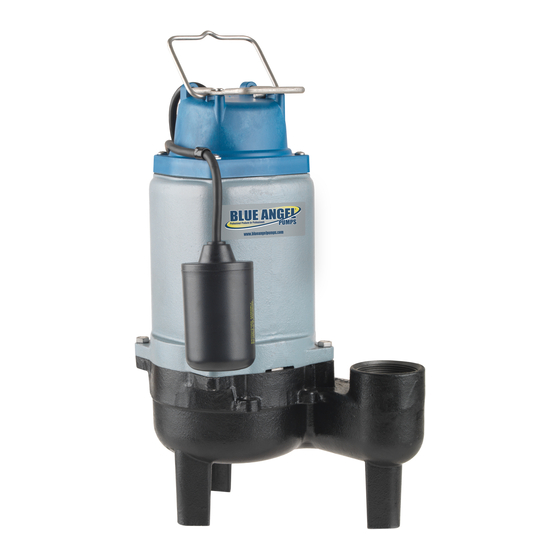Blue Angel Pumps 200SW 사용 설명서 및 부품 설명서 - 페이지 7
{카테고리_이름} Blue Angel Pumps 200SW에 대한 사용 설명서 및 부품 설명서을 온라인으로 검색하거나 PDF를 다운로드하세요. Blue Angel Pumps 200SW 12 페이지. Sewage pump

INSTALLATION MANUAL
TROUBLESHOOTING CHART (CONT'D)
Symptoms
Possible Cause(s)
Pump trips GFCI
1. Bad GFCI
2. Bad pump
Pump operates
1. Worn bearings
noisily or vibrates
2. Impeller broken
excessively
3. Piping attachments to building
structure too rigid or too loose
Pump will not
1. Switch
shut off
2. Switch obstructions
3. Restricted discharge (obstruction in
piping)
4. Excessive inflow or pump not
properly sized for application
Pump operates
1. Low supply voltage
but delivers little
2. Inlet clogged
or no water
3. Broken impeller
4. Pump not properly sized for
application
5. Check valve stuck closed or
installed backwards
6. Shut off valve closed
ROUTINE MAINTENANCE
The pump should be inspected 3-4 times per year for pump movement or buildup of debris on the switch or float. Reposition
pump if it has moved. Remove any debris that could interfere with the operation of the switch. Lack of proper routine maintenance
will void warranty.
• Make sure the pump is plugged in to a working ground fault circuit interrupter (GFCI) outlet and the cord is in good shape. In
damp areas, GFCI breakers may trip, effectively shutting off the effluent pump. Check in on your sewage pump and reset the
GFCI if necessary.
• Ensure the pump is standing upright. Vibrations during operation can cause it to fall or tilt onto one side. This can jam the float
so it can't activate the pump.
• Pour a bucket of water into the pit to make sure the pump starts automatically and the water drains quickly once the pump is
on. If the pump doesn't start, have it serviced or replaced.
• Replace the tether switch every two (2) years. This maintenance will reduce the risk of improper pump operation, switch failure
and/or flooding.
7
Suggested Remedies
1. Contact an electrician to replace GFCI
2. Replace pump
1. Replace pump
2. Replace pump
3. Install rubber coupling (available at local hardware stores) to isolate
pump vibration from discharge plumbing
1. Replace tether switch
2. Remove obstruction to verify free motion of switch
3. Remove obstruction from discharge piping
4. Recheck all sizing calculations to determine proper pump size
1. Contact an electrician
2. Remove debris
3. Replace pump
4. Recheck all sizing calculations to determine proper pump size
5. Remove and examine check valve for proper installation and free
operation
6. Open valve
